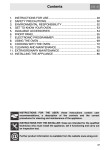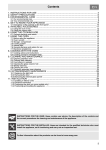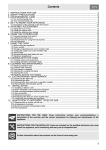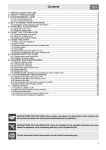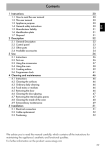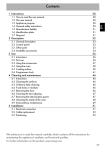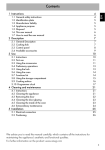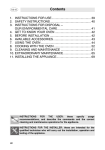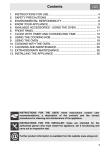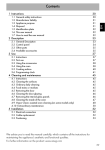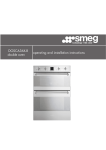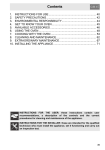Download Smeg DOSC36X
Transcript
Contents
1.
2.
3.
4.
5.
6.
7.
8.
9.
10.
11.
12.
INSTRUCTIONS FOR USE .............................................................. 48
SAFETY PRECAUTIONS ................................................................. 50
ENVIRONMENTAL RESPONSIBILITY ............................................. 52
GET TO KNOW YOUR OVEN ........................................................... 53
AVAILABLE ACCESSORIES ............................................................ 54
FRONT PANEL ................................................................................. 55
ELECTRONIC PROGRAMMER ....................................................... 59
USING THE OVEN............................................................................ 68
COOKING WITH THE OVEN ............................................................ 71
CLEANING AND MAINTENANCE .................................................... 78
EXTRAORDINARY MAINTENANCE ................................................ 81
INSTALLING THE APPLIANCE ........................................................ 85
INSTRUCTIONS FOR THE USER: these instructions contain user
recommendations, a description of the controls and the correct
procedures for cleaning and maintenance of the appliance.
INSTRUCTIONS FOR THE INSTALLER: these are intended for the qualified
technician who must install the appliance, set it functioning and carry out
an inspection test.
@
Further product information is available from the website www.smeg.com
47
General instructions
1. INSTRUCTIONS FOR USE
This manual is an integral part of the appliance and must therefore be kept in its
entirety and in an accessible place for the whole working life of the appliance.
It is important to carefully read this manual and all the instructions contained
herein before using the appliance. Installation must be carried out by competent
persons in accordance with the regulations in force. This appliance is intended
for household use and complies with te eec directives currently in force. The
appliance has been built to carry out the following functions: cooking food; any
other use is considered improper.
The manufacturer cannot be held liable for use other than as indicated.
This appliance has been manufactured to cook food, do not use the appliance to
heat rooms.
This appliance is marked according to european directive 2002/96/EC on waste
electrical and electronic equipment (weee).
This directive defines the standards for the collection and recycling of waste
electrical and electronic equipment applicable throughout the european union.
Do not obstruct ventilation openings and heat dispersal slits.
Do not rest any weight or sit on the open door of the appliance.
The identification plate bearing the technical data, serial number and brand
name is visibly applied on the appliance.
Do not remove this plate for any reason.
Before the appliance is put into operation, all the protective films applied inside
or outside must be removed.
Take care that no objects are stuck in the door of the oven.
The appliance becomes very hot during use. Suitable heat-proof gloves should
be worn for all operations.
48
General instructions
Do not use metallic sponges or sharp scrapers as they will damage
the surface.
Use normal non-abrasive products, including wooden or plastic
utensils if necessary. Rinse thoroughly and dry using a soft cloth or
chamois leather.
Do not allow residues of sugary foods (such as jam) to set inside the
oven. If they are allowed to set for too long, they could ruin the enamel
covering the inside of the oven.
Do not use plastic kitchenware or containers. The high temperatures inside the
oven could melt the plastic, damaging the appliance.
Do not use sealed tins or containers in the appliance. Overpressure may occur
inside the containers during cooking, creating a danger of explosion.
Do not leave the appliance unattended during cooking processes where fats or
oils could be released.
Fats and oils may catch fire.
Do not cover the bottom of the oven with aluminium or tinfoil sheets during
cooking and do not place pans or trays on it to avoid damage to the enamelled
surface.
If the surfaces are still very hot during cooking, do not pour water directly onto
the trays. The steam could cause severe burns and damage to enamelled
surfaces.
All cooking operations must be take place with the door closed.
49
General instructions
2. SAFETY PRECAUTIONS
Refer to the installation instructions for the safety regulations for electric or gas
appliances and ventilation functions.
In your interests and for your safety the law requires that the installation and
servicing of all electrical appliances is carried out by qualified personnel in
accordance with the regulations in force.
Our approved installers guarantee a satisfactory job.
Gas or electrical appliances must always be disconnected by suitably skilled
people.
Before connecting the appliance to the power grid, check the data on the plate
against the data for the grid itself.
Before carrying out installation/maintenance work, make sure that the appliance
is not connected to the power grid.
The plug to be connected to the power supply cable and its socket must be of
the same type and conform to the regulations in force.
The socket must be accessible after the appliance has been built in.
Never disconnect the plug by pulling on the cable.
If the power supply cable is damaged, contact the technical support service
immediately and they will replace it.
It is obligatory for all electrical equipment to be earthed according to the
methods laid down by safety regulations.
Immediately after installation, carry out a brief inspection test, following the
instructions below. Should the appliance not function, disconnect it from the
electricity supply and call the nearest technical support centre.
Never attempt to repair the appliance.
Do not use or leave flammable materials near the appliance or in the food
warming compartment.
During use the appliance becomes very hot. take care not to touch the heating
elements inside the oven.
This appliance must not be used by people (including children) of reduced
physical and mental capacity, or lacking in experience in the use of electrical
appliances, unless they are supervised or instructed by adults who are
responsible for their safety.
50
General instructions
Do not let children go near the appliance when it is in operation or play with it at
any time.
Do not insert pointed metal objects (cutlery or utensils) into the slits in the
appliance.
If the appliance is installed on caravans or boats, it must not be used to heat
rooms.
Do not use steam jets for cleaning the appliance.
The steam could reach the electronics, damaging them and causing shortcircuits.
Do not modify this appliance.
Do not spray any spray products near the electrical appliance while it is in
operation.
Do not use spray products while the product is still hot.
The manufacturer cannot be held liable for damage to persons or things caused
by failure to observe the above instructions, by interference with any part of the
appliance or by the use of non-original spare parts.
51
Instructions for disposal
3. ENVIRONMENTAL RESPONSIBILITY
3.1
Our environmental responsibility
Pursuant to Directives 2002/95/EC, 2002/96/EC and 2003/108/EC relating to
the reduction of the use of hazardous substances in electrical and electronic
appliances, as well as to the disposal of refuse, the crossed out bin symbol on
the appliance indicates that the product, at the end of its useful life, must be
collected separately from other refuse. Therefore, the user must consign the
product that has reached the end of its working life to the appropriate selective
collection centres for electrical and electronic refuse, or deliver it back to the
retailer when purchasing an equivalent product, on a one for one basis.
Adequate differentiated collection for the subsequent forwarding of the
decommissioned product to recycling, processing and ecologically compatible
disposal contributes to avoiding possible negative effects on the environment
and on health, and promotes recycling of the appliance’s constituent materials.
The illicit disposal of the product by the user results in the application of
administrative sanctions.
The product does not contain substances in quantities sufficient to be
considered hazardous to health and the environment, in accordance with
current European directives.
3.2
Your environmental responsibility
Our product’s packing is made of non-polluting materials, which are therefore
compatible with the environment and recyclable. Please help by disposing of the
packaging correctly. You can obtain the addresses of collection, recycling and
disposal centres from your retailer or from the competent local organisations.
Do not discard the packaging or any part of it, or leave it unattended. It can
constitute a suffocation hazard for children, especially the plastic bags.
Your old appliance also needs to be disposed of correctly.
Important: hand over your appliance to the local agency authorised for the
collection of electrical appliances no longer in use. Correct disposal enables
intelligent recovery of valuable materials.
Before disposing of your appliance it is important to remove doors and leave
shelves in the same position as for use, to ensure that children cannot
accidentally become trapped inside during play. It is also necessary to cut the
connecting cable to the power grid, removing it along with the plug.
52
Instructions for the user
4. GET TO KNOW YOUR OVEN
1
11
12
Control panel
1
10
2
3
9
8
4
7
6
5
Roof liner
(mobile)
2
3
6
4
Bulb
Oven seal
Roof liner
(fixed)
5
Pan and rack runners
3
6
7
Oven fan
8
Self-cleaning panels
4
1
A
2
3
6
4
5
3
6
7
4
53
Instructions for the user
5. AVAILABLE ACCESSORIES
NOTE: Some models are not provided with all accessories.
Rack: for holding cooking containers.
Tray rack: to be placed over the top of the oven
tray; for cooking foods which may drip.
Oven tray: for collecting fat from foods placed on
the rack above.
Accessories available on request:
Original supplied and optional accessories may be ordered from any Authorised
Support Centre.
Use original SMEG accessories only.
For the functions of the available accessories and their use, see chapter "8.
USING THE OVEN".
54
Instructions for the user
6. FRONT PANEL
All the controls and indicator lights can be seen on the front panel. The symbol
under each knob indicates the oven which it controls. The tables below describe
the symbols used.
1
8
2
6
11
12
4
3
8
5
2
3
8
4
7
8
8
1
10
9
1
3
2
6
5
7
A
SMALL OVEN THERMOSTAT KNOB
The cooking temperature is
selected by turning the knob
clockwise to the desired
setting, between 50°C and
270°C.
55
Instructions for the user
SMALL OVEN FUNCTION KNOB
Turn the knob clockwise or
anti-clockwise to select a
function for the small oven
from the following options:
GRILL FUNCTION
+ TOP RESISTANCE
+ BOTTOM RESISTANCE
SMALL GRILL FUNCTION
TOP RESISTANCE
+ BOTTOM RESISTANCE
LARGE GRILL FUNCTION
In the small oven the function with the least energy consumption is
LARGE OVEN THERMOSTAT KNOB
The cooking temperature is
selected by turning the knob
clockwise to the desired
setting, between 50°C and
250°C.
LARGE OVEN FUNCTION KNOB (on some models only)
Turn the knob clockwise or anti-clockwise to select a
function for the large oven from the following options:
56
THAWING FUNCTION
SMALL GRILL FUNCTION
+ VENTILATION
LARGE GRILL FUNCTION
LARGE GRILL FUNCTION
+ VENTILATION
SMALL GRILL FUNCTION
CIRCULAR FUNCTION
Instructions for the user
In the large oven the function with the least energy consumption is
LARGE OVEN FUNCTION KNOB (on some models only)
Turn the knob clockwise or anti-clockwise to select a
function for the large oven from the following options:
LARGE GRILL FUNCTION
CIRCULAR FUNCTION
LARGE GRILL FUNCTION
+ VENTILATION
THAWING FUNCTION
In the large oven the function with the least energy consumption is
ELECTRONIC PROGRAMMER - ANALOGUE CLOCK (on some models
only)
The programming clock can be used
to display the current time or to set a
timer or cooking programme.
TIMER BUTTON
VALUE DECREASE BUTTON
TIMED COOKING AND
SCHEDULED COOKING
BUTTON
VALUE INCREASE BUTTON
CLOCK ADJUSTMENT AND
RESET
57
Instructions for the user
ELECTRONIC PROGRAMMER - DIGITAL CLOCK (on some models only)
The programming clock can be used
to display the current time or to set a
timer or cooking programme.
TIMER BUTTON
VALUE DECREASE BUTTON
SCHEDULED COOKING
BUTTON
VALUE INCREASE BUTTON
TIMED COOKING BUTTON
MANUAL MODE BUTTON
THERMOSTAT INDICATOR LIGHT (orange)
During the oven heating phase the thermostat light remains on. Once
the oven has reached the set temperature the light turns off.
58
Instructions for the user
7. ELECTRONIC PROGRAMMER
7.1
Analogue clock (on some models only)
FUNCTION KEY LIST
TIMER BUTTON
TIMED COOKING AND
SCHEDULED COOKING
BUTTON
CLOCK ADJUSTMENT AND
RESET
VALUE DECREASE BUTTON
VALUE INCREASE BUTTON
THE ELECTRONIC PROGRAMMER ONLY CONTROLS THE LARGE OVEN
AND HAS NO CONTROL OVER THE SMALL OVEN
At the end of each completed programming operation, 10 beeps will sound 3
times at intervals of about 1 minute. This sequence can be stopped at any time
by pressing any key.
7.1.1 Setting the time
When the oven is used for the first time, or after an interruption in the electricity
supply, the display flashes at regular intervals.
To set the time proceed as follows:
•
Press
to stop the display flashing;
•
Press and hold
for 2 seconds. A flashing dot will be seen between 2 and
3. The time can now be set;
•
Press the value modification buttons
or
to increase or decrease the
setting by one minute for each pressure until reaching the desired time;
•
Press
or wait 5 seconds to exit the time setting mode.
59
Instructions for the user
7.1.2 Timer
The timer does not stop the cooking process. It only warns the user that the
preset number of minutes have passed.
•
Press
•
shown in figure 1;
Within 5 seconds press the value modification
buttons
and the display will light up as
or
in order to increase or
1)
decrease by one minute for each pressure until
reaching the desired time (1 hour and 10
minutes is shown in figure 2);
•
Press
or wait 5 seconds to exit the timer
•
setting mode;
The display will show the current time and the
symbol between 9 and 10;
•
To view the remaining time, press
2)
and
press it again to return to the current time view;
•
To silence the buzzer at the end of the time, press any button on the
programmer.
If the user wants to end cooking at the end of the time, the thermostat and oven
function knobs must be controlled manually.
A time longer than 4 hours cannot be set.
If
is pressed accidentally and no time setting is desired, press and hold
for about 5 seconds to cancel the settings.
60
Instructions for the user
7.1.3 Cooking duration
This function allows a cooking operation to be started and then stopped after a
specific length of time set by the user.
To set the cooking duration, proceed as follows:
• Rotate the oven thermostat knob to the desired
temperature
• Rotate the oven function knob to the desired
function
•
Press
position and the
•
1)
. The indicator will move to the 12
symbol between 11 and
12 will flash (Fig. 1).
Within 5 seconds press the value modification
buttons
or
in order to increase or
•
decrease by one minute for each pressure until
reaching the desired cooking time. For every
12 minutes a new internal segment will light up 2)
(1 hour and 12 minutes is shown in figure 2)
Wait about 5 seconds to start the function;
•
The display shows the current time, the
symbol appears between 11
and 12, the remaining minutes to complete cooking operation are
represented by the flashing internal segments (each internal segment
indicates 12 minutes);
•
Press
•
At the end of the cooking operation the timer will deactivate the oven heating
elements and the buzzer will sound. The numbers on the dial will flash.
to view the remaining time;
Warning: it is not possible to set cooking durations of more than 12 hours.
The set programming can be reset by pressing and holding
for 2 seconds.
By doing this the set duration will be cancelled and the oven must be turned off
manually if a cooking operation is in progress.
61
Instructions for the user
7.1.4 End of cooking
This function allows, as well as setting a cooking duration, a cooking end time to
be set (with a maximum delay of 12 hours in relation to the current time).
To set the cooking end time, proceed as follows:
• Rotate the oven thermostat knob to the desired temperature
•
Rotate the oven function knob to the desired function
•
Set the cooking duration as described in the previous point ("Cooking
duration");
•
Within 5 seconds press
to access the end cooking setting;
•
The current time will appear on the display with internal segments illuminated
to show the end of cooking time. The
•
symbol flashed between 10 and 11;
Within 5 seconds press the value modification buttons
or
to
increase or decrease the setting by one minute for each pressure until
•
reaching the desired cooking end time;
After about 5 seconds from the last adjustment
the display will show the current time, the
cooking end time and the cooking duration
which will be represented by the illuminated lit
segments. (here we can see a programming
example: the current time is 07:06 and cooking
is programmed to start at 08.06 and to end at
•
09.06);
When the current time coincides with the cooking start time the internal
segments on the display will begin to flash indicating that the oven has started
cooking;
•
At the end of the cooking time, the timer will switch the oven heating elements
off, the buzzer will start to sound and the numbers on the dial will flash;
The set programming can be reset by pressing and holding
for 2 seconds.
By doing this the set duration will be cancelled and the oven must be turned off
manually if a cooking operation is in progress.
62
Instructions for the user
7.1.5 Modifying the set data
The set cooking data can be modified at any time by pressing the function button
and then pressing the buttons
or
to change the value.
7.1.6 Reduced display brightness
In order to reduce energy consumption in stand-by, the brightness of the display
can be set to reduced mode by briefly pressing
brightness, press
. To return to normal
again.
63
Instructions for the user
7.2
Digital clock (on some models only)
FUNCTION KEY LIST
TIMER BUTTON
END OF COOKING BUTTON
COOKING DURATION
BUTTON
VALUE DECREASE BUTTON
VALUE INCREASE BUTTON
MANUAL MODE BUTTON
THE ELECTRONIC PROGRAMMER ONLY CONTROLS THE LARGE OVEN
AND HAS NO CONTROL OVER THE SMALL OVEN
7.2.1 Setting the time
When the oven is used for the first time, or after an interruption in the electricity
supply, the display flashes at regular intervals.
To set the time proceed as follows:
•
Press
. The dot between the hour and minute digits will flash and the
symbol will appear;
64
•
Press the value modification buttons
or
to increase or decrease the
•
setting by one minute for each pressure until reaching the desired time;
Wait about 5 seconds without pressing any buttons. The dot between the
hour and minute digits will stop flashing.
Instructions for the user
7.2.2 Using the timer
The timer does not stop the cooking process. It only warns the user that the
preset number of minutes have passed.
•
Press
. The display will show the digits
will flash while the
and the
symbol
symbol is fixed;
•
Press the value modification buttons
•
setting by one minute for each pressure until reaching the desired time;
Wait about 5 seconds without pressing any buttons to exit the timer setting
mode;
•
The current time and the
and
or
to increase or decrease the
symbols will appear between the
hour and minute digits;
•
To view the remaining time, press
and wait about 5 seconds to return to
the current time view;
•
To silence the buzzer at the end of the time, press
.
If the user wants to end cooking at the end of the time, the thermostat and oven
function knobs must be controlled manually.
A time longer than 4 hours cannot be set.
If
is pressed accidentally and no time setting is desired, press
to
cancel the settings.
65
Instructions for the user
7.2.3 Cooking duration
This function allows a cooking operation to be started and then stopped after a
specific length of time set by the user.
To set the cooking duration, proceed as follows:
• Rotate the oven thermostat knob to the desired temperature
• Rotate the oven function knob to the desired function
•
Press
. On the display the digits
will be shown;
•
Press the value modification buttons
•
setting by one minute for each pressure until reaching the desired time;
Wait about 5 seconds without pushing any buttons to start the function;
•
The current time, the A symbol and the
or
to increase or decrease the
symbol will be shown on the
display;
•
Press
to view the remaining time;
•
At the end of the time the timer will switch off the oven heating elements and
the buzzer will sound. The A symbol will flash and the
symbol will
disappear;
•
To silence the buzzer, press
and proceed with manually switching off
the oven if a cooking operation is in progress.
Warning: it is not possible to set cooking durations of more than 10 hours.
The set programming can be reset by pressing
. By doing this the set
duration will be cancelled and the oven must be turned off manually if a cooking
operation is in progress.
66
Instructions for the user
7.2.4 End of cooking
This function allows, as well as setting a cooking duration, a cooking end time to
be set (with a maximum delay of 24 hours in relation to the current time).
•
•
•
Rotate the oven thermostat knob to the desired temperature
Rotate the oven function knob to the desired function
Set the cooking duration as described in the previous point ("Cooking
duration");
•
Press
and the sum of the current time plus the preset cooking time will
appear on the display.
•
Press the value modification buttons
or
to increase or decrease the
•
•
setting by one minute for each pressure until reaching the desired time;
Wait about 5 seconds without pushing any buttons to start the function;
The current time and the A symbol will be shown on the display;
•
Press
to view the remaining time;
•
Press
to view the cooking end time;
•
At the end of the cooking operation the timer will deactivate the oven heating
elements and the buzzer will sound. The numbers on the dial will flash;
•
To silence the buzzer at the end of the time, press
and proceed with
manually switching off the oven if a cooking operation is in progress.
The set programming can be reset by pressing
. By doing this the set
duration will be cancelled and the oven must be turned off manually if a cooking
operation is in progress.
7.2.5 Modifying the set data
The set cooking data can be modified at any time by pressing the function button
and then pressing the buttons
or
to change the value.
67
Instructions for the user
8. USING THE OVEN
8.1
Before using the appliance
Remove any labels (apart from the technical data plate) from trays, dripping
pans and the cooking compartment.
Remove any protective film from the outside or inside of the appliance, including
from accessories such as trays, dripping pans, the pizza plate or the base cover.
Before using the appliance for the first time, remove all accessories from the
oven compartment and wash them as indicated in “10. CLEANING AND
MAINTENANCE”.
Heat the empty appliance to the maximum temperature in order to remove
any manufacturing residues which could affect the food with unpleasant odours.
8.2
General Description
8.2.1 Cooling system
The appliance is equipped with a
cooling system which comes into
operation as soon as a cooking
function starts. The fan causes a
steady outflow of air from above the
door which may continue for a brief
period of time even after the oven has
been turned off.
68
Instructions for the user
8.2.2 Oven inside lights
The oven lights come on when the door is opened or any function is selected.
If the oven light fails, replace it as described in “11.1 Replacing the light bulb”.
8.2.3 Oven runners
The oven features 5 runners and 3
shelves for positioning trays and racks
at different heights. The insertion
heights are numbered from the bottom
upwards (see the example in the
figure).
8.2.4 Using the rack
The racks are equipped with a
mechanical safety lock which prevents
them from being taken out accidentally.
To insert the rack correctly, check that
the lock is facing downwards (as
shown in the figure).
To take it out, lift the front edge of the
rack slightly while sliding it out on the
side runners.
The mechanical lock must always
face the back of the oven.
Insert racks and trays fully into the oven until they come to a stop.
69
Instructions for the user
8.2.5 Using the support rack
The support rack is inserted into the
tray (as shown in the figure).
Using this, foods can be cooked and
the fat can be collected separately from
the food which is being cooked.
8.3
Warnings and general advice for usage
All cooking operations must be carried out with the door closed.
During cooking, do not cover the bottom of the oven with aluminium or tin foil
and do not place pans or oven trays on it as this may damage the enamel
coating. If you wish to use greaseproof paper, place it so that it will not interfere
with the hot air circulation inside the oven.
For the best cooking results, we recommend placing cookware in the centre of
the rack.
To prevent any steam in the oven from creating problems,
open the door in two stages: half open (5 cm approx.) for
4-5 seconds and then fully open. If you need to access
the food, always leave the door open for as short a time
as possible to prevent the temperature in the oven from
falling and ruining the food.
To prevent excessive amounts of condensation from forming on the internal
glass, hot food should not be left inside the oven for too long after cooking.
70
Instructions for the user
9. COOKING WITH THE OVEN
ECO:
Using the grill and the lower heating element in combination is
particularly suitable for cooking on a single runner only, as it
provides low energy consumption.
STATIC:
As the heat comes from above and below at the same time, this
system is particularly suitable for certain types of food.
Traditional cooking, also known as static or thermal radiation
cooking, is suitable for cooking just one dish at a time. Perfect
for all types of roasts, bread and cakes and in any case
particularly suitable for fatty meats such as goose and duck.
GRILL:
The heat coming from the grill element gives perfect grilling
results, especially for thin and medium thickness meat and, in
combination with the rotisserie (when present), it allows the
food to be browned evenly at the end of cooking. Perfect for
sausages, ribs and bacon. This function enables large
quantities of food, particularly meat, to be grilled evenly.
SMALL GRILL: (on some models only)
Using only the heat released from the central element, this
function enables small portions of meat and fish to be grilled for
making kebabs, toasted sandwiches and all types of grilled
vegetable side dishes.
FAN-ASSISTED GRILL:
The air produced by the fan softens the strong heat wave
generated by the grill, giving perfect grilling results even with
very thick foods. Perfect for large cuts of meat (e.g. shin of
pork).
FAN-ASSISTED SMALL GRILL: (on some models only)
Through the combined action of the fan and the heat of the
central element only, this function is perfect for rapid cooking
and cooking au gratin of small quantities of food (particularly
meats), by bringing together the dietary advantages of the grill
and the even cooking of the fan.
71
Instructions for the user
CIRCULAR:
The combination of the fan and the circular element
(incorporated in the rear of the oven) enables different foods to
be cooked on several levels, as long as they need the same
temperature and cooking time. Hot air circulation ensures
instant and uniform distribution of heat. It will be possible, for
instance, to cook fish, vegetables and biscuits simultaneously (on different
levels) without mixing smells and flavours.
(For multiple-level cooking, you are advised to use the 2nd and 4th runners).
DEFROSTING:
Rapid defrosting is helped by switching on the fan and the top
heating element to ensure uniform distribution of lowtemperature air inside the oven.
9.1
Cooking advice and instructions
9.1.1 General advice
We recommend preheating the oven before putting the food in.
•
For cooking on several levels, we recommend using a fan-assisted function
(
•
) to achieve uniform cooking at all heights.
In general, it is not possible to shorten the cooking times by increasing the
temperature (the food could be well-cooked on the outside and undercooked
on the inside).
9.1.2 Advice for cooking meat
•
•
72
Cooking times, especially for meat, vary according to the thickness and
quality of the food and to consumer taste.
We recommend using a meat thermometer for meat when roasting it.
Alternatively, simply press on the roast with a spoon: if it is hard it is ready, if
not, it needs another few minutes cooking.
Instructions for the user
9.1.3 Advice for cooking desserts and biscuits
•
•
•
•
Use dark metal moulds for desserts: they help to absorb the heat better.
The temperature and the cooking duration depend on the quality and
consistency of the dough.
Check whether the dessert is cooked all the way through: at the end of the
cooking time, put a toothpick into the highest point of the dessert. If the
dough does not stick to the toothpick, the dessert is cooked.
If the dessert collapses when it comes out of the oven, on the next occasion
reduce the set temperature by about 10 °C, selecting a longer cooking time if
necessary.
9.1.4 Advice for defrosting and proving
The defrosting function enables any type of food to be defrosted. To start
defrosting, turn the oven function knob to
, then a ventilation system will go
into operation to ensure uniform distribution of the ambient temperature inside
the oven.
The defrosting time will depend on the quantity of food to be defrosted.
• We recommend positioning frozen foods in a lidless container on the first
runner of the oven.
• The food must be defrosted without its wrapping.
• Lay out the foodstuffs to be defrosted evenly, not overlapping.
• When defrosting meat, we recommend using a rack positioned on the
second runner with the food on it and a tray positioned on the first runner. In
this way, the liquid from the defrosting food drains away from the food.
• The most delicate parts can be covered with aluminium foil.
• For successful proving, a container of water should be placed in the bottom
of the oven.
9.1.5 Advice for cooking with the Grill and the Fan-assisted grill
•
Using the Grill function
, meat can be grilled even when it is put into the
oven cold; preheating is recommended if you wish to change the effect of the
cooking.
•
With the Fan-assisted grill function
•
preheat the oven before grilling.
We recommend placing the food at the centre of the rack.
, however, we recommend that you
73
Instructions for the user
9.2
To save energy
To save energy during use of the appliance, the following instructions may be
followed:
• Stop cooking a few minutes before the time normally used. Cooking will
continue for the remaining minutes with the heat which has accumulated
inside the oven.
• Reduce any opening of the door to a minimum to avoid heat dispersal.
• Use the ECO function for cooking on a single runner.
• Keep the inside of the appliance clean at all times.
74
Instructions for the user
9.3
Cooking tables
The times indicated in the following tables do not include the preheating times
and are provided as a guide only.
9.3.1 Large oven
POS. OF
THE
RUNNER
FROM
BOTTOM
TEMP.
(°C)
TIME
(minutes)
WEIGHT
(Kg)
LASAGNE
1
220 / 230
50 / 60
3/4
OVEN-BAKED PASTA
1
220 / 230
40
2
ROAST VEAL
2
180 / 190
70 / 80
1
LOIN OF PORK
2
180 / 190
70 / 80
1
SHOULDER OF PORK
2
180 / 190
90 / 100
1
ROAST RABBIT
2
180 / 190
70 / 80
1
TURKEY BREAST
2
180 / 190
80 / 90
1,5
ROAST NECK OF PORK
2
180 / 190
190 / 210
2
ROAST CHICKEN
2
180 / 190
70 / 80
1
PORK CHOPS
5
270
20 + 6
1
PORK CHOPS
3
270
15 + 5
1
HAMBURGERS
4
270
9+5
0.8
SAUSAGE
4
270
17
1
BACON
4
270
13 + 3
0.8
DISHES
FUNCTION
FIRST COURSES
MEAT
GRILLED MEATS *
*For this type of food the indicated cooking time is understood to be "per side" (i.e. "Bacon
13 + 3" corresponds to "13’ on 1 side + 3’ on side 2")
75
Instructions for the user
POS. OF
THE
RUNNER
FROM
BOTTOM
TEMP.
(°C)
TIME
(minutes)
WEIGHT
(Kg)
SALMON TROUT
2
150 / 160
35 / 40
1
PIZZA
1
250
6 / 10
1
BREAD
2
190 / 200
25 / 30
1
FOCACCIA
2
180
20 / 25
0.8
DOUGHNUT
2
160
50 / 60
1
FRUIT TART
2
160 / 170
30 / 35
1
SHORT PASTRY
2
160 / 170
20 / 25
0.5
PARADISE CAKE
2
160
55 / 60
1
LIGHT SPONGE CAKE
2
150 / 160
45 / 50
0.8
RICE PUDDING
2
160
40 / 50
1
DISHES
FUNCTION
FISH
DESSERTS
76
Instructions for the user
9.3.2 Small oven
POS. OF
THE
RUNNER
FROM
BOTTOM
TEMP.
(°C)
TIME
(minutes)
WEIGHT
(Kg)
LASAGNE
1
220 / 230
50 / 60
3/4
OVEN-BAKED PASTA
1
220 / 230
40
2
LOIN OF PORK
1
180 / 190
70 / 80
1
ROAST RABBIT
1
180 / 190
70 / 80
1
TURKEY BREAST
1
180 / 190
80 / 90
1,5
ROAST CHICKEN
1
190 / 200
55 / 60
1
PORK CHOPS
3
250 / 270
15 + 5
1
PORK CHOPS
3
270
13 + 4
1
SAUSAGE
3
250 / 270
15
1
1/2/3
270
8+9
0.8
SALMON TROUT
1
250 / 270
14 / 16
1
PIZZA
1
250
6 / 10
1
FOCACCIA
1
190 / 200
18 / 20
0.8
FRUIT TART
1
170 / 180
35 / 40
1
SHORT PASTRY
1
170 / 180
20 / 25
0.5
DISHES
FUNCTION
FIRST COURSES
MEAT
GRILLED MEATS *
BACON
FISH
DESSERTS
*For this type of food the indicated cooking time is understood to be "per side" (i.e. "Bacon
13 + 3" corresponds to "13’ on 1 side + 3’ on side 2")
77
Instructions for the user
10.CLEANING AND MAINTENANCE
NEVER USE A STEAM JET FOR CLEANING THE APPLIANCE.
10.1 Cleaning stainless steel
To keep stainless steel in good condition it should be cleaned regularly after use.
Let it cool first.
10.2 Ordinary daily cleaning
To clean and preserve the stainless steel surfaces, always use only specific
products that do not contain abrasives or chlorine-based acids.
How to use: pour the product onto a damp cloth and wipe the surface, rinse
thoroughly and dry with a soft cloth or chamois leather.
10.3 Food stains or residues
Do not use metallic sponges or sharp scrapers as they will damage the surface.
Use normal non-abrasive products and a wooden or plastic tool if necessary.
Rinse thoroughly and dry with a soft cloth or chamois leather.
Do not allow residues of sugary foods (such as jam) to set inside the oven. If left
to set for too long, they might damage the enamel lining of the oven.
10.4 Cleaning the door glazing
The glass in the door should always be kept thoroughly clean. Use absorbent
kitchen roll; remove stubborn dirt with a damp sponge and an ordinary
detergent.
Do not use abrasive or corrosive cleaners for cleaning the door glazing.
(e.g. powder products, oven-cleaner sprays, stain removers and metal scouring
pads).
Do not use rough or abrasive materials or sharp metal scrapers to clean the
oven’s glass doors since they may scratch the surface and cause the glass to
shatter.
78
Instructions for the user
10.5 Cleaning the inside of the oven
For the best oven upkeep, clean it
regularly after having allowed it to
cool.
•
Take out all removable parts;
•
Clean the oven racks with hot
water and non-abrasive detergent.
Rinse and dry;
•
For easier cleaning, the door can
be removed (see “11.2 Removing
the door”).
The oven should be operated at the maximum heat setting for 15/20 minutes
after use of specific products, to burn off the residues left inside the oven.
When the operation is complete, damp parts should be dried thoroughly.
79
Instructions for the user
10.6 Removing guide frames
Removing the guide frames makes it
easier to clean the side walls of the
oven.
To remove the guide frames proceed
as follows:
•
pull the front part of the frame
toward the inside of the oven in
order to unhook it from its housing
3;
•
slide the frame out of the seats
located on the back 4;
•
When cleaning is complete,
repeat the above procedures in
reverse order to put the guide
frames back in.
4
3
10.7 Removal of self-cleaning side panels (on some models only)
Removing the self-cleaning panels
makes it easier to clean the side walls
of the oven.
80
•
Remove the guide frames as
described in paragraph "10.6
Removing guide frames";
•
Separate the self-cleaning panels
from the guide frames, removing
the ends of the frames from the
slots on the panels;
•
When cleaning is complete,
repeat the above procedures in
reverse order to put the selfcleaning panels back in.
1
2
Instructions for the user
11.EXTRAORDINARY MAINTENANCE
The oven may require extraordinary maintenance or replacement of parts
subject to wear such as gaskets, bulbs, etc. The following instructions describe
how to carry out these minor maintenance operations.
Before any intervention that requires access to live parts, disconnect the
appliance from the power supply.
If a problem cannot be resolved through ordinary maintenance or in the case of
other types of fault, contact your local technical support centre.
11.1 Replacing the light bulb
If a light bulb needs to be replaced because it is worn or burnt out, proceed as
follows:
•
Remove the guide frames, see “10.6
Removing guide frames”.
•
Remove the bulb cover using a tool
(e.g. a screwdriver);
•
Remove the bulb by unscrewing it as
shown;
•
Replace the bulb with one of the same
type (25W - T300°C);
•
Reassemble the cover being careful
that the moulded part of the glass is
facing the base of the bulb;
•
Press the cover down as far as it will
go so that it attaches completely to the
bulb support.
81
Instructions for the user
11.2 Removing the door
•
Open the door completely;
•
Insert pins
2
in the hinge holes
;
1
•
Lift the door about 30°;
•
Remove the door by gripping it on the
sides;
Repositioning of the door:
•
Insert the hinges in the corresponding
slots on the oven;
•
ensure that the grooves
on the
hinges rest completely against the
slots;
•
82
Lower the door and remove the pins
from the hinges.
3
Instructions for the user
11.3 Removing the door seal
To permit thorough cleaning of the oven,
the door seal may be removed.
There are fasteners on all four sides to
attach it to the edge of the oven. Pull the
edges of the seal outwards to detach the
fasteners.
11.4 Removing the internal glass panels
The glass in the oven door should always be kept thoroughly clean. For easier
cleaning, the door can be removed (see 11.2 Removing the door) and placed on
a canvas.
The glass panels of the door can be completely removed by following the
instructions provided below.
Warning: before removing the glass panels, make sure that at least one of the
door’s hinges has been locked in the open position as described in “11.2
Removing the door”. This operation may have to be repeated during the glass
removal process if the door is accidentally freed.
83
Instructions for the user
Removing the internal glass panel:
to disconnect the glass securing pins:
• Lift the rear part following the motions
indicated (1).
•
Lift the front part following the motions
indicated (2)
•
Remove the middle pane by lifting it
upwards;
Cleaning:
• Clean the external glass panel and the
panels
which
were
previously
removed. Use absorbent kitchen roll.
In the case of stubborn dirt, wash with
a damp sponge and neutral detergent;
Replacing the glass panels:
• Replace the panels in the reverse of
the order in which they were removed;
•
84
Centre and insert the 4 pins secured
to the internal pane into their seats on
the oven door using light pressure.
Instructions for the installer
12.INSTALLING THE APPLIANCE
12.1 Electrical connection
The identification plate bearing the technical data, serial number and brand
name is visibly positioned on the appliance.
Do not remove this plate for any reason.
The appliance must be connected to earth in compliance with electrical system
safety regulations.
If the appliance is connected to the power supply network by means of a fixed
connection, install a multipolar cut-out device on the power supply line, in
accordance with the installation rules, located near the appliance and in an
easily reachable position.
If a plug and socket connection is being used, make sure that the plug and
socket are compatible. Avoid use of adapters and shunts as these could cause
overheating and risk of burns.
Use H05VV-F type rubber cable and during positioning ensure that there is no
contact with the metallic parts of the external frame of the appliance To access
the terminal block, remove the rear cover of the appliance as described in
paragraph "12.2 Cable replacement". If necessary, change the position of the
jumpers on the terminal block as shown in the figure, then connect the cables,
ensuring that the earth cable is at least 20 mm longer than the others. Secure
the power cable to the appliance using the included cable ties.
WARNING: The values indicated above refer to the cross-section of the internal
conductor.
220 - 240V ~
Three pole 3 x 4 mm² H05VV-F
20 mm
380 - 415V 2N~
Four pole 4 x 1.5 mm² H05VV-F
20 mm
85
Instructions for the installer
12.2 Cable replacement
•
Unscrew the securing screws
from the cover terminal;
•
Remove the tabs
•
cover terminals;
Loosen the cable securing screws
from the lower part of the rear of the
oven
•
•
•
from the
;
Loosen the terminal cables;
Replace the cable securing it to the
terminal as described on the label
on the rear of the appliance;
When the cable has been replaced
repeat the steps described above in
reverse.
1
2
3
Make sure that the cables follow the best route in order to avoid any contact with
the oven.
WARNING: The tightening torque of the screws of the terminal supply wires
must be 1.5 - 2 Nm.
86
Instructions for the installer
12.3 Positioning the oven
Never use the oven door to lever the oven into place when fitting. Avoid exerting
too much pressure on the oven door when open.
It is recommended to install the oven with the help of a second person.
The base on which the oven is resting must be complete as shown in the
illustrations below.
Under the large oven door, the counter
must not protrude at least 1 cm. This is
in order to allow complete opening of
the door.
The oven is designed for mounting into any piece of furniture as long as it is
heat-resistant. For positioning, follow the dimensions of the counter indicated in
figure 1-2-3 and the operational dimensions of the oven indicated in figure 4-5.
Depending on the installation possibilities a ventilation opening must be
prepared for the appliance. This opening must be
• or on the lower/front part of the counter (figure 1) for a total surface of at
least 200 cm².
• either on the upper/rear part of the counter (figure 2) of 35-40 mm deep;
To secure the appliance to the counter, screw in 6 screws through the holes in
the frame indicated in figure 6.
87
Instructions for the installer
FIG. 1
FIG. 2
35-40
875
875
490-500
875
min. 550
200 cm²
875
min. 550
FIG. 3
FIG. 4
554 - 564
16
22
875
869
880
88
4
545
Instructions for the installer
FIG. 5
FIG. 6
550
7
59
89












































